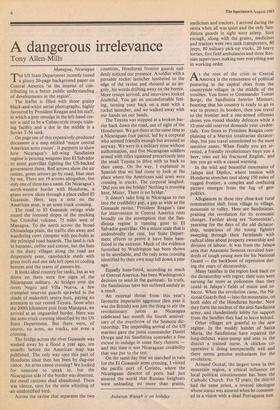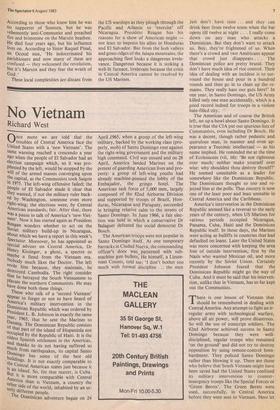A dangerous irrelevance
Tony Allen-Mills
Managua, Nicaragua The US State Department recently issued a glossy 20-page background paper on Central America 'in the interest of con- tributing to a better public understanding of developments in the region'.
The leaflet is filled with those grainy black-and-white aerial photographs, highly favoured by President Reagan and his staff, in which a grey smudge in the left-hand cor- ner is said to be a Cuban-style troops train- ing facility and a dot in the middle is a Soviet T-54 tank.
On page ten of this expensively-produced document is a map entitled 'major central American arms routes'. It purports to show how Nicaragua's left-wing Sandinista regime is pouring weapons into El Salvador to assist guerrillas fighting the US-backed government there. Red arrows show the air routes, green arrows go by road, blue ones by sea. There are 19 arrows altogether, but only one of them has a name. On Nicaragua's north-western border with Honduras, a green arrow slices through a place called El Guasaule. Here, says a note on the American map, is an arms truck crossing.
The road to El Guasaule swings wide round the forested slopes of the smoking San Cristobal volcano, 75 miles west of Managua. To the north across the broad Chinandega plain, the traffic dies away and wandering cows compete with pot-holes as the principal road hazards. The land is rich in bananas, coffee and cotton, but the huts in the dusty villages along the road are desperately poor, ramshackle sheds with grass roofs and one side left open to cooling breezes and the stares of passers-by.
It looks ideal country for tanks, but as we drove on there were few signs of the Nicaraguan military. At bridges over the rivers Negro and Villa Nueva, a few crumpled reservist guards sprawled in the shade of makeshift sentry huts, paying no attention to our rented Toyota. Soon after the 200th kilometre post from Managua, we arrived at an unguarded border. Here was the arms truck crossing identified by the US State Department. But there were, of course, no arms, no trucks, not even a crossing.
The bridge across the river Guasaule was washed away by a flood a year ago, ten months before the American map was published. The only way into this part of Honduras since then has been by dug-out canoe. An arms canoe crossing? We looked for someone to speak to, but the Nicaraguan side of the border was deserted, the metal customs shed abandoned. There was silence, save for the eerie whistling of an unidentified bird.
Across the ravine that separates the two countries, Honduran frontier guards sud- denly noticed our presence. A soldier with a portable rocket launcher lumbered to the edge of the ravine and shouted at us an- grily, his words drifting away on the breeze. More troops arrived, and interviews looked doubtful. You get an uncomfortable feel- ing, turning your back on a man with a rocket launcher, and we walked away with our hands on our heads.
The Toyota was stopped at a broken bar- rier back down the road, out of sight of the Hondurans. We got there at the same time as a Nicaraguan foot patrol, led by a corporal who seemed friendly enough but arrested us anyway. We were in a military zone without authorisation, and five Nicaraguan soldiers armed with rifles squeezed precariously into the small Toyota to drive with us back to their camp. On the way, I explained in Spanish that we had come to look at the place where the Americans said arms were crossing in trucks. The corporal laughed. `Did you see the bridge? Nothing is crossing here, Mister. There is no bridge.'
It doesn't take long in Nicaragua to run into the credibility gap, a gap as wide as the Guasaule ravine.' President Reagan's case for intervention in Central America rests broadly on the assumption that the San- dinista regime is running guns to El Salvador guerrillas. On a minor scale that is undoubtedly the case, but State Depart- ment efforts to prove it have been ham- fisted in the extreme. Much of the evidence furnished by Washington has been shown to be unreliable, and the only arms crossing identified by their own map fell down a year ago.
Equally ham fisted, according to much of Central America, has been Washington's decision to send in the gunboats. In truth, the Sandinistas have not suffered unduly as a result.
An external threat from this year's favourite imperialist aggressor (last year it was the British) was just the thing to stir the revolutionary juices as Nicaragua celebrated last month the fourth anniver- sary of the overthrow of the Somoza dic- tatorship. The impending arrival of the US marines gave the junta commander Daniel Ortega and his Sandinista comrades a fine excuse to indulge in some fiery rhetoric and this time it was Nicaraguan credibility that was put to the test.
On the same day that we searched in vain for the El Guasaule arms crossing, I visited the pacific port of Corinto, where the Nicaraguan director of ports had just assured the world that Russian freighters were unloading no more than grains, medicines and tractors. I arrived during the siesta when all was quiet and the only San- dinista guards in sight were asleep. Sure enough, along with the grains, medicines and tractors were two tank transporters, 80 jeeps, 80 military pick-up trucks, 20 heavy lorries, five field ambulances and three Rus- sian supervisors making sure everything was in working order.
At the root of the crisis in Central America is the remoteness of political posturing in the capital cities from the countryside villages in the middle of the troubles. You listen to Commander Tomas Borge, the Sandinista Interior Minister, boasting that his country is ready to go to war to protect its borders, then you travel to the frontier and a one-armed rifleman shows you round shoddy defences while a 12-year-old reservist demands your creden- tials. You listen to President Reagan com- plaining of a Marxist totalitarian dictator- ship, but you travel unmolested to the most sensitive zones. When finally you get ar- rested, a friendly revolutionary buys you a beer, tries out his fractured English, and lets you go with a casual warning.
In the wild and beautiful mountains of Jalapa and Dipilto, where tension with Honduras stretches taut along 150 miles of rugged frontier, a complex and confusing picture emerges from the fog of geo- politics.
Allegiances in these tiny close-knit rural communities shift from village to village, mountain to valley. Here are Sandinistas, praising the revolution for its economic changes. Further along are `Somozistas', yearning for the days of the old dictator- ship, suspicious of the young fighters sweeping through their farmlands with radical ideas about property ownership and division of labour. It was from the Jalapa area that Anastasio Somoza recruited hun- dreds of tough young men for his National Guard — the backbone of repression dur- ing the years of dictatorship.
Many families in the region look back on the dictatorship with regret: their sons were earning far more as policemen than they could in Jalapa's fields of maize and to- bacco. When the revolution came, the Na- tional Guards fled — into the mountains, on both sides of the Honduran border. Now they form the nucleus of the anti-Sandinista army, and clandestinely lobby for support from the families they had to leave behind.
Other villages are grateful to the new regime. In the muddy hamlet of Santa Maria, the Sandinistas have repaired the long-defunct water-pump and sent to the district a trained nurse. A chicken co- operative is doing unexpectedly well and there seems genuine enthusiasm for the revolution.
Around Ocotal, the largest town in this mountain region, a critical influence on local political consciousness has been the Catholic Church. For 52 years, the district had the same priest, a revered ideologue whose status was assured when he commun- ed in a vision with a dead Portuguese nun. According to those who knew him he was no supporter of Somoza, but he was vehemently anti-Communist and preached fire and brimstone on the Marxist heathen. He died four years ago, but his influence lives on. According to Sister Raquel Pinal, an Ocotal nun, 'He indoctrinated his parishioners and now many of them are confused — they welcomed the revolution, but it's Marxist and they fear the wrath of God .'
These local complexities are distant from
the US warships as they plough through the Pacific and Atlantic to 'exercise' off Nicaragua. President Reagan has his reasons for a show of American might — not least to impress his allies in Honduras and El Salvador. But from the lush valleys and green ridges of the Jalapa mountains, the approaching fleet looks a dangerous irrele- vance. Dangerous because it is stoking a well-lit furnace, irrelevant because the crisis in Central America cannot be resolved by the US Marines.







































 Previous page
Previous page